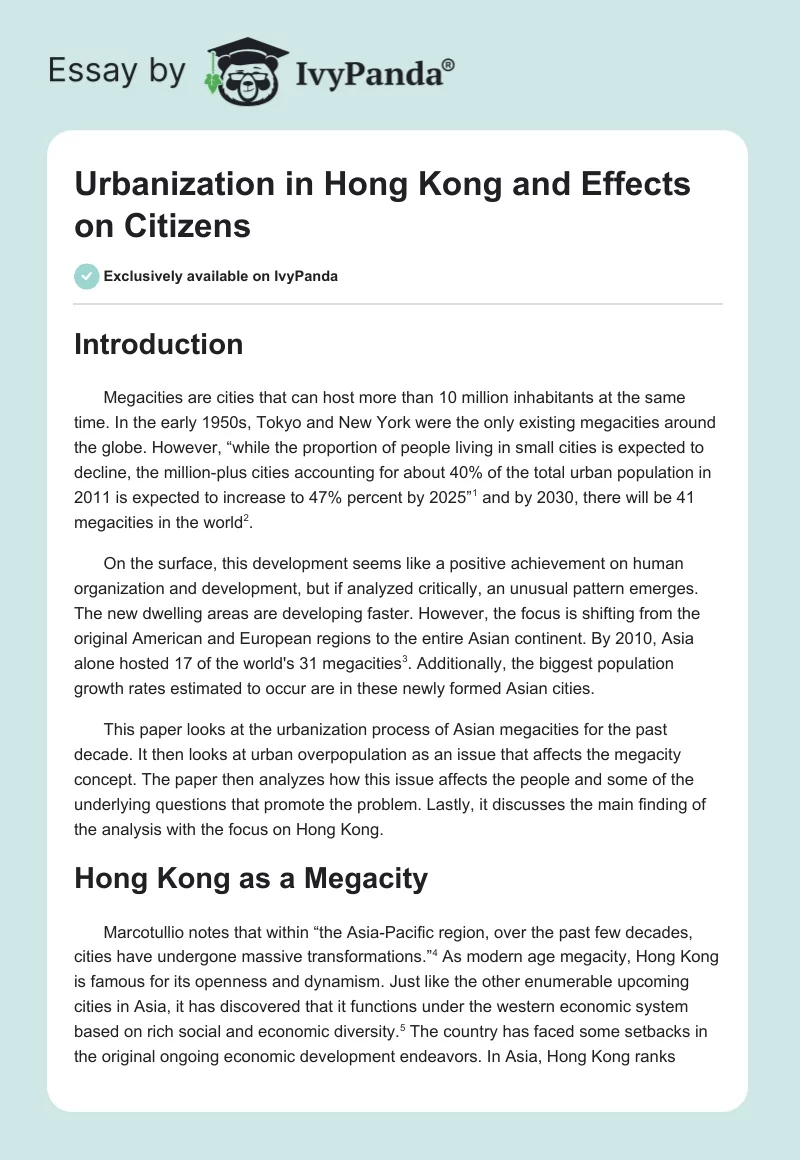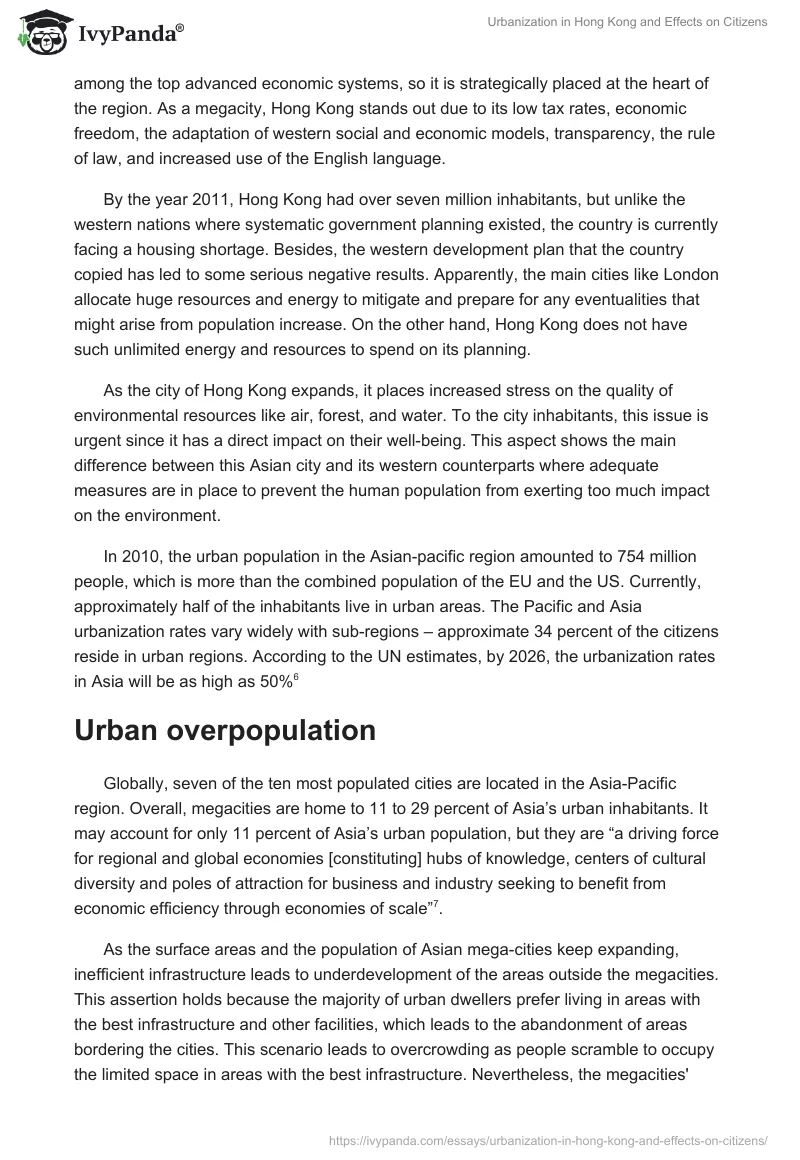Introduction
Megacities are cities that can host more than 10 million inhabitants at the same time. In the early 1950s, Tokyo and New York were the only existing megacities around the globe. However, “while the proportion of people living in small cities is expected to decline, the million-plus cities accounting for about 40% of the total urban population in 2011 is expected to increase to 47% percent by 2025” and by 2030, there will be 41 megacities in the world.
On the surface, this development seems like a positive achievement on human organization and development, but if analyzed critically, an unusual pattern emerges. The new dwelling areas are developing faster. However, the focus is shifting from the original American and European regions to the entire Asian continent. By 2010, Asia alone hosted 17 of the world’s 31 megacities. Additionally, the biggest population growth rates estimated to occur are in these newly formed Asian cities.
This paper looks at the urbanization process of Asian megacities for the past decade. It then looks at urban overpopulation as an issue that affects the megacity concept. The paper then analyzes how this issue affects the people and some of the underlying questions that promote the problem. Lastly, it discusses the main finding of the analysis with the focus on Hong Kong.
Hong Kong as a Megacity
Marcotullio notes that within “the Asia-Pacific region, over the past few decades, cities have undergone massive transformations.” As modern age megacity, Hong Kong is famous for its openness and dynamism. Just like the other enumerable upcoming cities in Asia, it has discovered that it functions under the western economic system based on rich social and economic diversity. The country has faced some setbacks in the original ongoing economic development endeavors.
In Asia, Hong Kong ranks among the top advanced economic systems, so it is strategically placed at the heart of the region. As a megacity, Hong Kong stands out due to its low tax rates, economic freedom, the adaptation of western social and economic models, transparency, the rule of law, and increased use of the English language.
By the year 2011, Hong Kong had over seven million inhabitants, but unlike the western nations where systematic government planning existed, the country is currently facing a housing shortage. Besides, the western development plan that the country copied has led to some serious negative results.
Apparently, the main cities like London allocate huge resources and energy to mitigate and prepare for any eventualities that might arise from population increase. On the other hand, Hong Kong does not have such unlimited energy and resources to spend on its planning.
As the city of Hong Kong expands, it places increased stress on the quality of environmental resources like air, forest, and water. To the city inhabitants, this issue is urgent since it has a direct impact on their well-being. This aspect shows the main difference between this Asian city and its western counterparts where adequate measures are in place to prevent the human population from exerting too much impact on the environment.
In 2010, the urban population in the Asian-pacific region amounted to 754 million people, which is more than the combined population of the EU and the US. Currently, approximately half of the inhabitants live in urban areas. The Pacific and Asia urbanization rates vary widely with sub-regions – approximate 34 percent of the citizens reside in urban regions. According to the UN estimates, by 2026, the urbanization rates in Asia will be as high as 50%.
Urban overpopulation
Globally, seven of the ten most populated cities are located in the Asia-Pacific region. Overall, megacities are home to 11 to 29 percent of Asia’s urban inhabitants. It may account for only 11 percent of Asia’s urban population, but they are “a driving force for regional and global economies [constituting] hubs of knowledge, centers of cultural diversity and poles of attraction for business and industry seeking to benefit from economic efficiency through economies of scale.”
As the surface areas and the population of Asian mega-cities keep expanding, inefficient infrastructure leads to underdevelopment of the areas outside the megacities. This assertion holds because the majority of urban dwellers prefer living in areas with the best infrastructure and other facilities, which leads to the abandonment of areas bordering the cities. This scenario leads to overcrowding as people scramble to occupy the limited space in areas with the best infrastructure.
Nevertheless, the megacities’ growth pace can exceed the national average it can only happen in the case of a higher level of poverty and social discrimination. The urban primacy rate, i.e. the number of people residing in the largest and most developed city in a country, over time has undergone a decline in relative terms. Apparently, the percentage of people living in major cities is increasing by the day, and this trend is expected to persist into the future.
Main Factors Behind the Issue
Rural communities adopted migration as methods of enhancing their household livelihoods and capitalizing from better urban area services. This strategy is a good way for them to invest in various economic and rural housing projects. Individuals migrating to urban areas eye the employment opportunities and improved lifestyles, which cannot compare to countryside scenario where little economic endeavors take place.
In Asia, megacities also gain from the constant supply of human labor that comes from rural areas. Women empowerment also benefits from internal migration as women get direct access to employment outside the traditional home confines.
However, some countries choose to constrain internal population movements so that the governments can monitor population movements in the urban areas. This governmental policy can help reverse or reduce the migration flows through establishing “rural employment creation programs, anti-slum drives and restricted entry to urban areas.”
Nevertheless, despite the barriers, rural populations continue to migrate to cities. A majority of those who moved from rural to urban parts of the country become employed in the informal sector for lengthy periods, and thus they are excluded from obtaining the extensive economic growth benefits in the megacities.
In some cases, acts of God displace people, which are then forced to move to urban centers. For example, when the cities are located near areas affected by natural disasters, they very often become the recipients of the displaced persons who were forced to move due to environmental changes. These predicted numbers are expected to increase in the future as the disasters become more frequent. Moreover, in many Asian countries, sudden outbursts of the population were often caused because of the conflicts.
Underlying factors
Eighty percent of Asia’s gross domestic product comes from just 40 percent of the population that resides in cities. Conventionally, urbanization creates avenues for improved GDP and increased productivity, as industries and services are mostly concentrated in cities. However, not all of those who live in urban areas can enjoy equal benefits from economic growth. Over half of the world’s slum dwellers reside in the Asian megacities.
What is more, in some areas, the levels of inequality and discrimination have reached alarming rates. The urban population percentage living in slums, i.e. “households with no durable housing, insufficient living space, no access to water nor sanitation,” has escalated since 1990, and by 2010, it reached 30.8 percent, which is approximately 500 million people.
The pace at which Asian megacities are developing is unsustainable in the long-term, which may cause serious problems in all aspects of living in the areas including pollution, overcrowding, and global warming among others. Environmental unsustainability lies at the core of the expected challenges that may hinder the growth and sustenance of Asian megacities.
For example, “the World Health Organization ranks outdoor air pollution as the 13th greatest contributor to disease and death worldwide, causing an estimated 519,000 premature deaths every year, especially in urban areas.” Apparently, Asian cities are highly likely to experience acts of God based on the available data on natural disasters.
Implications
Approximately more than a sixth of the global populations reside in just 700 cities, which combined generate half of the global production. However, most of these cities have little influence over their policies, budgets, and planning. Reports show that by 2025, 60 percent of Hong Kong residents will reside in megacities, but the question remains on how they can cope if they cannot obtain useful sources and autonomy over the funds.
Many Asian cities have little authority to charge their citizens or tax them for electricity or water let alone provide meaningful public transport, improved sewerage services, or roads that might enhance the residents’ life. People are stuck in thinking regarding the nation-state aspect.
However, globally, many people who move to megacities often remain administratively powerless. Regardless of how people approach the issue, it will be impossible to tie down a vast bulk of humanity in agriculture in the near future. Three-quarters of the global population by 2025 will be urban. This assertion implies that more people will mean more megacities. These projected cities are an integral part of humanity’s future, and the implications should be both fascinating and scary.
The examples of Seoul, Hong Kong, and Tokyo prove that megacities do not always have negative consequences. For a majority of the residents, the megacities are their livelihoods. Going forward, the focus should be on how to manage that uncertain future as opposed to shying away from its impacts.
The general social behavior may also affect a city’s sustainability. Most likely, the development of megacities will reflect the citizens’ consumerism culture. This assertion holds because as wealth grows, income matches consumption. Therefore, even though consumerism may aid in uplifting the economy, it also signifies that more energy is needed to produce the necessary goods. Heightened public awareness and education, as well as policymakers on the developmental and environmental problems faced, are the first step towards the struggle to alleviate the current situation.
Production processes and consumption patterns of the masses will also inevitably have to experience transformation for the long-term sustainability of the Asian megacities. Currently, sustainability seems far-fetched as current environmental challenges change regularly, but experts tend to remain powerless in influencing policy change. With the establishment of more Asian megacities in the possibly near future, the new century beginning should be an appropriate time for planners, politicians, and citizens as a unit to renew their resolve to establish a more sustainable environment for them and the future generations.
Conclusion
As a new century and millennium dawns, humanity is facing unprecedented opportunities and challenges arising from the acceleration of urbanization and the emergence of megacities mainly in Asia. The changes that revolve around these megacities have been monumental, but the development patterns and models are not sustainable.
Different aspects of urbanization need to be addressed including elevated resource depletion, population growth, global warming, poverty, and pollution growth if hazard vulnerability and environmental degradation are to be managed sustainably.
The current signs indicate extended natural and good balance problems in Asia’s large coastal cities and the rate at which people are expanding as they migrate. The view that the Asian coastal regions are in problem underscores the current trends of development widely embraced in these areas. One underlying issue is that there is less concern about possible sea-level rise and overpopulation despite the view that these aspects will be a bigger challenge in the future.
Bibliography
Marcotullio, Peter John. “Globalization, urban form and environmental conditions in Asia-Pacific cities.” Urban Studies 40, no. 2 (2003): 219-247.
Ong, Aihwa. Neoliberalism as exception: Mutations in citizenship and sovereignty. Durham Duke University Press, 2006.
Singh, Raju. Urban Development Challenges, Risks, and Resilience in Asian Mega Cities. New York: Springer, 2015.
Spence, Michel, Patricia Annez, and Robert Buckley. Urbanization and Growth. Washington D.C: World Bank Publications, 2008.
United Nations Department of Economic and Social Affairs. World Urbanization Prospects: The 2014 Revision. Highlights. New York: United Nations, 2014.
United Nations Economic and Social Commission for Asia and the Pacific. Urbanization Trends in Asia and the Pacific. New York: United Nations, 2014.


